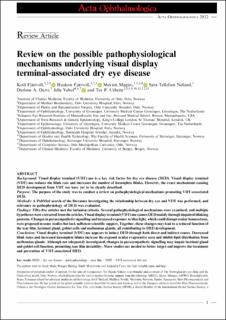| dc.contributor.author | Fjærvoll, Ketil Andreas Olsen | |
| dc.contributor.author | Fjærvoll, Haakon Kristoffer Olsen | |
| dc.contributor.author | Magnø, Morten Scherven | |
| dc.contributor.author | Tellefsen Nøland, Sara Julie Maria | |
| dc.contributor.author | Dartt, Darlene Ann | |
| dc.contributor.author | Vehof, Jelle | |
| dc.contributor.author | Utheim, Tor Paaske | |
| dc.date.accessioned | 2023-01-09T10:15:12Z | |
| dc.date.available | 2023-01-09T10:15:12Z | |
| dc.date.created | 2022-04-30T14:48:12Z | |
| dc.date.issued | 2022 | |
| dc.identifier.citation | Fjærvoll, K., Fjærvoll, H., Magno, M., Nøland, S. T., Dartt, D. A., Vehof, J., & Utheim, T. P. (2022). Review on the possible pathophysiological mechanisms underlying visual display terminal‐associated dry eye disease. Acta ophthalmologica. | en_US |
| dc.identifier.issn | 1755-375X | |
| dc.identifier.uri | https://hdl.handle.net/11250/3041882 | |
| dc.description.abstract | Background
Visual display terminal (VDT) use is a key risk factor for dry eye disease (DED). Visual display terminal (VDT) use reduces the blink rate and increases the number of incomplete blinks. However, the exact mechanisms causing DED development from VDT use have yet to be clearly described.
Purpose
The purpose of the study was to conduct a review on pathophysiological mechanisms promoting VDT-associated DED.
Methods
A PubMed search of the literature investigating the relationship between dry eye and VDT was performed, and relevance to pathophysiology of DED was evaluated.
Findings
Fifty-five articles met the inclusion criteria. Several pathophysiological mechanisms were examined, and multiple hypotheses were extracted from the articles. Visual display terminal (VDT) use causes DED mainly through impaired blinking patterns. Changes in parasympathetic signalling and increased exposure to blue light, which could disrupt ocular homeostasis, were proposed in some studies but lack sufficient scientific support. Together, these changes may lead to a reduced function of the tear film, lacrimal gland, goblet cells and meibomian glands, all contributing to DED development.
Conclusion
Visual display terminal (VDT) use appears to induce DED through both direct and indirect routes. Decreased blink rates and increased incomplete blinks increase the exposed ocular evaporative area and inhibit lipid distribution from meibomian glands. Although not adequately investigated, changes in parasympathetic signalling may impair lacrimal gland and goblet cell function, promoting tear film instability. More studies are needed to better target and improve the treatment and prevention of VDT-associated DED. | en_US |
| dc.language.iso | eng | en_US |
| dc.publisher | Wiley | en_US |
| dc.rights | Navngivelse 4.0 Internasjonal | * |
| dc.rights.uri | http://creativecommons.org/licenses/by/4.0/deed.no | * |
| dc.title | Review on the possible pathophysiological mechanisms underlying visual display terminal-associated dry eye disease | en_US |
| dc.title.alternative | Review on the possible pathophysiological mechanisms underlying visual display terminal-associated dry eye disease | en_US |
| dc.type | Peer reviewed | en_US |
| dc.type | Journal article | en_US |
| dc.description.version | publishedVersion | en_US |
| dc.rights.holder | The author | en_US |
| dc.subject.nsi | VDP::Medisinske Fag: 700 | en_US |
| dc.source.pagenumber | 17 | en_US |
| dc.source.journal | Acta Ophthalmologica | en_US |
| dc.identifier.doi | 10.1111/aos.15150 | |
| dc.identifier.cristin | 2020343 | |
| dc.relation.project | Norges forskningsråd: 271555 | en_US |
| cristin.ispublished | true | |
| cristin.fulltext | original | |
| cristin.qualitycode | 2 | |

